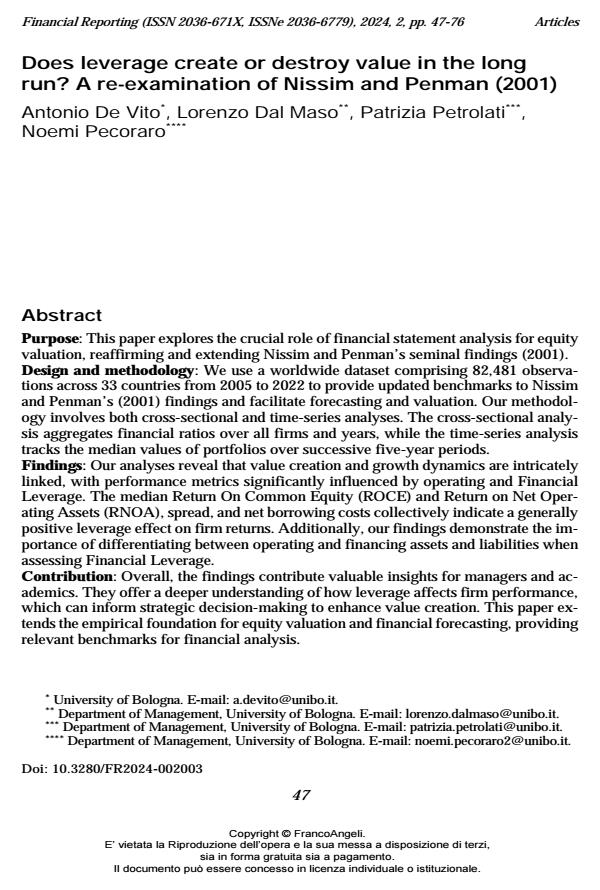Does leverage create or destroy value in the long run? A re-examination of Nissim and Penman (2001)
Titolo Rivista FINANCIAL REPORTING
Autori/Curatori Antonio De Vito, Lorenzo Dal Maso, Patrizia Petrolati, Noemi Pecoraro
Anno di pubblicazione 2024 Fascicolo 2024/2
Lingua Inglese Numero pagine 30 P. 47-76 Dimensione file 291 KB
DOI 10.3280/FR2024-002003
Il DOI è il codice a barre della proprietà intellettuale: per saperne di più
clicca qui
Qui sotto puoi vedere in anteprima la prima pagina di questo articolo.
Se questo articolo ti interessa, lo puoi acquistare (e scaricare in formato pdf) seguendo le facili indicazioni per acquistare il download credit. Acquista Download Credits per scaricare questo Articolo in formato PDF

FrancoAngeli è membro della Publishers International Linking Association, Inc (PILA)associazione indipendente e non profit per facilitare (attraverso i servizi tecnologici implementati da CrossRef.org) l’accesso degli studiosi ai contenuti digitali nelle pubblicazioni professionali e scientifiche
Purpose: This paper explores the crucial role of financial statement analysis for equity valuation, reaffirming and extending Nissim and Penman’s seminal find-ings (2001). Design and methodology: We use a worldwide dataset comprising 82,481 obser-vations across 33 countries from 2005 to 2022 to provide updated benchmarks to Nissim and Penman’s (2001) findings and facilitate forecasting and valuation. Our methodology involves both cross-sectional and time-series analyses. The cross-sectional analysis aggregates financial ratios over all firms and years, while the time-series analysis tracks the median values of portfolios over successive five-year periods. Findings: Our analyses reveal that value creation and growth dynamics are intri-cately linked, with performance metrics significantly influenced by operating and Financial Leverage. The median Return On Common Equity (ROCE) and Return on Net Operating Assets (RNOA), spread, and net borrowing costs collectively indi-cate a generally positive leverage effect on firm returns. Additionally, our findings demonstrate the importance of differentiating between operating and financing assets and liabilities when assessing Financial Leverage. Contribution: Overall, the findings contribute valuable insights for managers and academics. They offer a deeper understanding of how leverage affects firm per-formance, which can inform strategic decision-making to enhance value creation. This paper extends the empirical foundation for equity valuation and financial forecasting, providing relevant benchmarks for financial analysis.
Parole chiave:financial statement analysis, ratio analysis, equity valuation, operating leverage, financial leverage
Jel codes:G32, H25, H26, M41
Antonio De Vito, Lorenzo Dal Maso, Patrizia Petrolati, Noemi Pecoraro, Does leverage create or destroy value in the long run? A re-examination of Nissim and Penman (2001) in "FINANCIAL REPORTING" 2/2024, pp 47-76, DOI: 10.3280/FR2024-002003